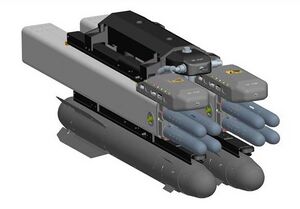Agkulis missile
| Agkulis | |
|---|---|
 Agkulis missiles shown mounted with two Scorpion missiles | |
| Type | Air-to-surface missile Surface-to-Surface missile |
| Service history | |
| In service | 2007 |
| Used by | see operators |
| Production history | |
| Manufacturer | BAU Systems |
| Specifications | |
| Weight | 15.75 kg (34.7 lb) |
| Length | 1.8034 m (5.917 ft) |
| Diameter | 0.07 m (2.8 in) |
| Warhead | Warhead dependant |
Operational range | 12 km (7.5 mi) Fixed-wing 5 km (3.1 mi) Rotor-wing/Ground |
| Speed | exceeds 1,653.1 mph (2,660.4 km/h) |
Guidance system | Semi-active laser homing/Pre-fire radar lock |
Launch platform | Fixed-wing aircraft Rotor-wing aircraft Ship-launched Vehicle-launched (mounted) |
The Agkulis missile is a multi-role missile first developed for air-to-surface usage but was further developed to be used from land-based launchers as well. It entered development around the same time as it's bigger brother, the Scorpion missile with the intention of being paired to the larger missile for engaging closer-range targets. The weapon system was quickly adopted by the Belfrasian Armed Forces for usage either with the Scorpion or independently by ground personnel.
Overview
The Agkulis was developed with the intention of being paired with the larger Scorpion missile, as a result the launcher system for the Agkulis missile is capable of being installed wherever an Scorpion will fit. Ground units which fit the larger missile into a sealed pod are able to utilise a stripped down launch system which will 'plug' into the same system and deliver four missiles in place of the singular, more capable Scorpion.
The missile system is a child of the Ankule missile, an unguided missile that is physically similar to the Agkulis albeit almost a full meter shorter. The meter added to the Agkulis provides it with it's increased range at height and guided abilities. Despite the development and introduction of the Agkulis, the
The launcher system is wholly plug-and-play with existing Scorpion missile software, capable of uploading target data to each missile before launch, at which point the missile will be guided into the target by laser designation. In contrast with the larger missile, the Agkulis has a modular base form and is capable of having it's fuse and warhead swapped out to meet challenges in the field as necessary. The system launches the missile with compressed gas to separate it from the launch vehicle before it's main motor starts to prevent damage to internal electronics of the launch device.
When mounted onto the same system as a Scorpion, the launcher system consists of four missiles with integrated electronics and launch compression system. An 'add-on' system for the older Ankule missile launchers allow them to carry the Agkulis, although the missile protrudes half a meter in both directions and the add-on system is bolted onto the system to interface with the missiles guidance and engine system. This was considered a 'fix-it' solution for the first few years of the missiles life and is rarely seen in usage today.
Entities that the Agkulis missile was first brought into service with, the Republic Navy and Republic Air Force, began utilising the Agkulis almost exclusively in tandem with the larger Scorpion. The larger, more expensive Scorpion being used in this combination to strike armoured targets whilst the Agkulis is used to strike unarmoured targets such as light vehicles or dismounted enemy personnel with the fletchett warheads available. The missile system has been since deployed with the Belfrasian Army both on their helicopter platforms and on ground vehicles as a short-range anti-surface missile. The inclusion of a warhead which deploys a parachute-dropped flare allowed for dumb-fire missiles lacking the guidance to deploy illumination to targets at range for forward observers, forward fighting infantry, or any other means. During a training operation in 2008 the flare platform was successful used by a Harma IFV to illuminate forces playing the role of opposing forces (OPFOR).
Variants
The full name of variants are Agkulis-Mod/ followed by their designation. The easiest way to differentiate the two types of variants (Fuses and warheads) is that warheads start at 100 and fuses start at 400.
Fusing options
- 425PD
- Nose mounted impact detonation for slow-speed launch platforms such as helicopters or vehicles.
- 430PD
- Nose mounted impact detonation fuse for high-speed launch platforms such as fixed-wing aircraft.
- 437PD
- Mid-body impact detonation fuse for both platforms, only mountable with small payloads.
- 443AB
- Proximity-delay fuse for air bursting munitions. 443AB/A is a sub-fuse that triggers opening arms for deploying cluster munitions.
- 448AB
- Mid-body air burst fuse
- 461PH
- Armoured head for penetrating armour prior to detonation.
- 465PH
- Armoured head for penetrating armour with payload dispersing fuse.
- 472DF
- Dumb-fire warhead with time delay detonation or release, user selectable prior to launch.
Warhead options
- 110HE
- Most common warhead. 3.9kg warhead mounted mid-body for area detonation.
- 118HE
- Shaped-charge variant of 110HE for forward blast of both HE and missile debris.
- 122HE
- Heavier 4 KG dual purpose anti-tank warhead, coupled with PH fuses.
- 131WP
- Single 7.7 kg White Phosphorus munition
- 145MM
- Multi-mission air burst pod for carrying 5 kg of ordnance.
- 162SM
- Discharges three smoke munitions at target for 1 hr of light breeze cover.
- 165FM
- Discharges one parachute-dropped flare at target.
- 172CM
- 1,179 3.75 gram flechettes for area anti-personnel firing with air burst fuse.
- 175CM
- 2,200 1.3 gram flechettes for area anti-personnel firing with air burst fuse.
- 181CM
- 32 cluster munitions for carrying CS gas with air burst fuses.
